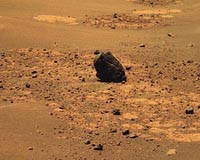 |
Huntsville AL (SPX) Dec 04, 2009 Homer's Iliad tells the story of Troy, a city besieged by the Greeks in the Trojan War. Today, a lone robot sits besieged in the sands of Troy while engineers and scientists plot its escape. Welcome to "Troy" - Mars style. NASA's robotic rover Spirit is bogged down on the Red Planet in a place the rover team named after the ancient city. So why aren't scientists lamenting? "The rover's spinning wheels have broken through a crust, and we've found something supremely interesting in the disturbed soil," says Ray Arvidson of the Washington University in St. Louis. Spirit, like its twin rover Opportunity, has roamed the Red Planet for nearly 6 years. During that time, the rover has had some close calls and come out fighting from each. In fact, it's been driving backwards since one of its wheels jammed in 2006. From the beginning, the rovers' motto has been "follow the water." Both rovers have been searching Mars for minerals formed in the presence of H2O. Mars appears dry today, but minerals can provide clues that water was once there. "It's been easy for Opportunity to find such minerals," explains Arvidson. "Opportunity landed in an ancient lake bed. Spirit has had to work much harder. Spirit landed in basaltic plains formed by lava flows chewed up by repeated meteoroid impacts. There's been little evidence of anything that was ever very wet." But when Spirit reached an area of Mars called the "Columbia Hills," the whole complexion of the mission changed. "Spirit came across iron hydroxide, a mineral that forms in the presence of water. That alerted us to the change. We started coming across more and more rocks formed in the presence of water." Then Spirit got stuck in a patch of loose soil on the edge of a small crater. Heavy sigh. Stuck again. But wait! "Spirit had to get stuck to make its next discovery," says Arvidson. As the rover tried to break free, its wheels began to churn up the soil, uncovering sulfates underneath. "Sulfates are minerals just beneath the surface that shout to us that they were formed in steam vents, since steam has sulfur in it. Steam is associated with hydrothermal activity - evidence of water-charged explosive volcanism. Such areas could have once supported life." "And most amazingly, the boundary between the sulfate-rich soil and the soil with just the generic concentration of sulfates runs right down the middle of the stranded rover. Spirit is lodged on the edge of a crater - sitting astride the boundary!" "Also, the robot found that the top of the sulfate material is crusty. Ancient sulfates probably formed this crust as they were processed by variations in climate associated with changes in Mars' orbit over millions of years." Here's what the scientists think: When a Martian pole faces the sun in Martian summer, it gets warmer at that pole and the water ice shifts to the equator. It even snows there! Warm dark soil under the snow causes the bottom layer of snow to melt. The water trickles into the sulfates, dissolving the water-soluble iron sulfates and forming a crust with the calcium sulfates remaining. "By being stuck at Troy, Spirit has been able to teach us about the modern water cycle on Mars." Indeed, Spirit's saga at Troy has given scientists material evidence of past water on Mars on two time scales: ancient volcanic times, and cycles ongoing to the present day. "We've sat here for more than 6 months. That's a long time to take measurements. We've learned a lot. Troy is a good place to be under siege, but we're ready to leave." Will Spirit break free to continue its incredible journey? Tune in to Science@NASA to find out if the escape plan works. Share This Article With Planet Earth
Related Links Mars Rovers at JPL Mars Rovers at Cornell Mars News and Information at MarsDaily.com Mars News and Information at MarsDaily.com Lunar Dreams and more
 Opportunity Continues Study Of 'Marquette'
Opportunity Continues Study Of 'Marquette'Pasadena CA (SPX) Dec 01, 2009 Opportunity has been investigating the rock known as "Marquette Island" over the last couple of weeks. This target is proving to be something unique that Opportunity has not encountered in more than 2000 Sols of exploring Mars. The science team is theorizing this rock could be either be a type of meteorite that Opportunity has never seen before or it could be ejecta from deep within the ... read more |
|
| The content herein, unless otherwise known to be public domain, are Copyright 1995-2009 - SpaceDaily. AFP and UPI Wire Stories are copyright Agence France-Presse and United Press International. ESA Portal Reports are copyright European Space Agency. All NASA sourced material is public domain. Additional copyrights may apply in whole or part to other bona fide parties. Advertising does not imply endorsement,agreement or approval of any opinions, statements or information provided by SpaceDaily on any Web page published or hosted by SpaceDaily. Privacy Statement |